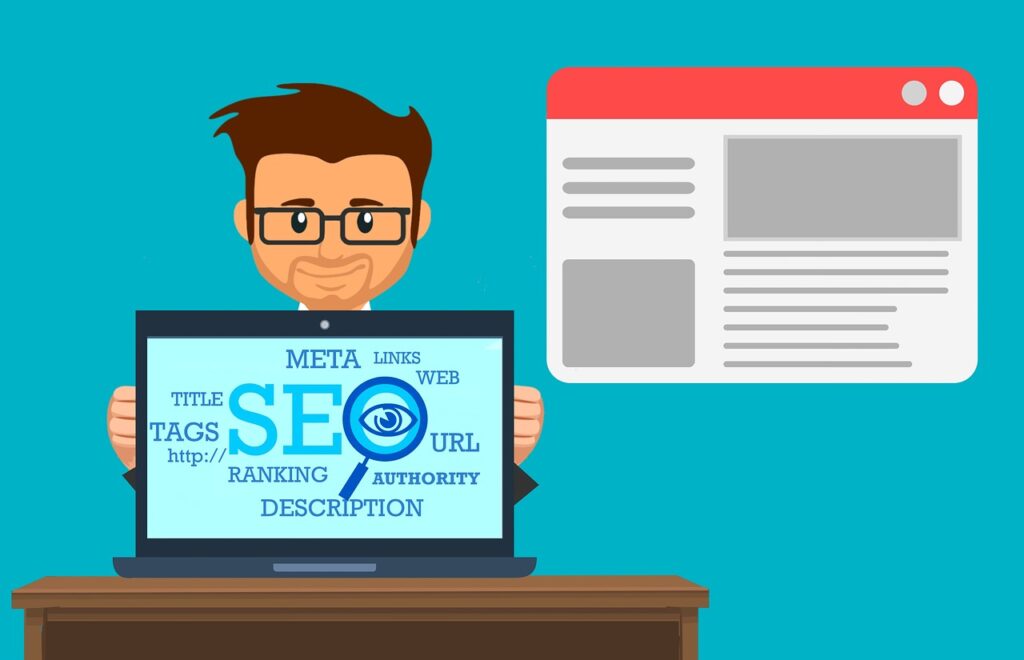8 SEO Tasks to Help You Rank Higher in the SERPs
It’s a shame when a newcomer enters the world of online marketing with hopes and dreams about earning a living as their own boss, only to struggle with technical and strategical details they’re unaware of.
Search engine optimization (SEO) is one of those pesky things every blogger and site owner has to stay informed about – especially since the rules and guidelines evolve over a period of time.
Whether you want to be an affiliate marketer, an info product creator, or pursue any other number of business model opportunities, SEO is going to be a skill that can help you dominate over your competition and secure your shot at making a lot of money.
There are eight fundamental SEO tasks that everyone should familiarize themselves with and learn how to leverage for the benefit of their site’s ranking in the SERPs (search engine results pages).
Below, you’ll discover what those SEO tasks are and gain some insight about how to go about making sure you’ve mastered these skills in an effort to help you get more targeted traffic and stay on the good side of Google and other search engines.

1 – Start with a Fast-Loading, Mobile-Friendly Site
Google is the primary search engine people try to rank for because it’s the main search engine consumers use to find information they’re seeking. But these good practices can help you rank in almost all of the various search engines.
Page load times are very important because they don’t want people to click away and begin using another search engine that will deliver better results. If your consumer is waiting for more than 4 seconds, maximum, chances are they’re going to go somewhere else.
Ideally, your page will load within two seconds. There are ways you can test the page load speed of your site. You can go to Google’s PageSpeed Insights and enter your URL to see what the analysis will deliver.
They will perform a diagnostic test on your domain and give you the results. If your site isn’t loading quickly, make sure you check out their Opportunities section to see how you can make improvements.
You might see things like your site needs to reduce unused JavaScript, your images need to be better compressed, and more. This isn’t the only tool that can help you improve your site, so find one that you feel is easy for you to use.
Another thing you have to make sure of is that your site is mobile-friendly. Consumers now use a variety of devices to search for information and to shop for things they want to buy online.
Responsive layouts are the best option for sites because it can scale itself according to whatever device the user is on. Other things you can do to make sure your site is good for mobile users is to avoid or carefully use pop-ups and keep your site clean looking.
If it’s difficult to navigate on a small screen, it can cause problems for your users. If possible, test your site’s appearance on a variety of devices such as an iPhone, iPad, Android phone, laptop, PC and anything else you can think of.
Keep in mind that just because you fix these things once, it doesn’t mean you’ll never have to check load times or mobile-friendliness again. Every time you change blog themes or add a new plugin, the capabilities of your site can be altered, such as bogging down the speed or making it look odd on mobile devices.
2 – Begin Dominating the SERPs Using Long-Tail Keywords
In the early days of the Internet, online entrepreneurs had fierce competitions to see who could rank high for very broad, 1-2 word keywords and phrases. But these days, many marketers are seeing the value in taking a different route.
Ranking for short keywords and phrases at this stage is a long-haul effort. You have to build a high authority site in order to achieve this goal. But even a newcomer with a new website can effectively target and rank well for a long-tail keyword phrase.
These are phrases that are 3 or more words in length. So while it might be difficult for you to rank for a phrase like best diet, you could create content and tags that help you get found for a phrase like best diet for women over 40.
With long-tail keyword phrases, the longer it is, the easier it is to rank for. One of the best ways to find these is to use a keyword tool (free or paid). Start with a broad keyword and keep typing to see what long-tail searches develop.
For example, if you go to Google and start typing the phrase lose weight, you might see lose weight in 2 weeks and then you’ll see more long-tail options like lose weight in 2 weeks without exercise, lose weight in 2 weeks with apple cider vinegar, and lose weight in 2 weeks for wedding.
Of course, you want to use them in a way that logically makes sense. For example, the phrase lose weight in 2 weeks for wedding isn’t how we would say it. We might say for a wedding or for my wedding.
But you can keep the phrase intact by adding words after it such as lose weight in 2 weeks for wedding plans or lose weight in 2 weeks for wedding photos. Those make sense logically.
Use the long-tail keyword phrases (and variations of them) in your content, in the blog post title, in the tags and even in the alt tags if you have any images embedded in the post.
3 – Learn How to Get Chosen as the Featured Snippet on Google
Whenever you search for something on Google, you’ll often see what’s known as a featured snippet at or near the top of the page. This is prime virtual real estate when it comes to your rankings, and many people are trying to discover exactly how to be what Google wants in order to secure that top spot.
In essence, it’s a quick summary answer as opposed to a blog link with a pretext of a sentence. You get ample space to showcase your knowledge, but you also get that coveted hyperlink to your full post, too.
Here’s an example of one that shows up when you type the phrase how to lose weight fast into Google:
The reason Google uses these is because they know some people are in a rush and just want a fast answer to their query. This positioning is commonly known as Position Zero because they appear above normal search results.
While most listings in the SERPs show the hyperlink and page title first and then a snippet about the website’s content, an official Google snippet reverses this and shows the snippet of information (in a longer format) followed by the title of the page with the hyperlink.
You can’t choose to be a snippet – and there’s no way to submit your content as a potential result for this position. Google has to choose you. But there are ways you can increase your chances of being chosen as a featured snippet.
Using long-tail keyword phrases is a great way to increase your chance of getting featured snippet positioning. Use questions such as, “What’s the fastest way to lose weight?”
Give your answers in a numbered list using a header format for each item so that they stand out. Try to make sure each subheading that you’re using answers the question in full.
If you look at the example shown in the image above, you’ll notice that each item is a complete idea, and kept short – such as: Trying intermittent fasting, Tracking your diet and exercise, and so on.
When someone clicks through on their web page, they’ll find that each of those subheadings has a more thorough answer of several paragraphs and detail for each one.

4 – Know the Power of Internal and Incoming Backlinks
If you ask a wide variety of marketers, they’ll have differing opinions about whether or not backlinks are an important part of your SEO strategy. A more important question might be, “What’s the best way to get backlinks to a site?”
This is because many people had such a strong desire to game the system, that they started getting as many backlinks as possible from any type of source. This is not the best way to go about it, so backlinks might not be as strong as they once were – but they’re still important.
You want backlinks to grow organically. Buying 200 backlinks where Google can see a huge number in 24-48 hours is an obvious scam (known by Google as a link scheme) that they won’t look favorably on.
A better method is to try to grow your backlinks organically and slowly as you create stellar content that is naturally rewarded with a link so other sites’ audiences can see the information.
You want the sites linking back to your to be authority niche sites. Google and other search engines look at the quality of the link, not just the number of links you have pointing to your domain.
Internal linking is beneficial for both your human visitors and the search bots crawling your site. When you have a lot of content on your site, it stands to reason that some content can be expanded in certain areas by pointing to another post on your site.
For example, if you’re blogging about losing weight with a calorie deficit and you mention choosing the right food scale, you can link to a page on your site that reviews the top 10 food scales – or one that tells people how to use them.
Make sure you’re using anchor text for these internal links so that the visitor knows what you’re linking out to. Don’t just paste the entire domain. This also helps bots gain an understanding of what the linked content is all about.
You want the visitor to have an enjoyable experience on your site, so don’t spam your content with dozens of internal links. Having a couple on the page (or a few) is plenty – but there’s no need to go through a blog post and hyperlink to another page for every possible word or phrase possible.
You might want to make a spreadsheet or list of all of the pages on your site so that you can easily search for a topic and create an internal hyperlink to something relevant. You can cluster the topics together if you want, such as having a cluster of CrossFit pages, a cluster of strength training pages, and so on.
You can also have internal links that do something similar to how Amazon uses their “Also bought” recommendations. Once someone finishes reading a blog post, you might share 1-2 other links on topics that are related to the one they’re on that they may also like.
5 – Implement On-Page Content SEO Advice
Most online entrepreneurs look at search engine optimization as a whole whenever they are planning a strategy to help their site rank better in the SERPs. But in addition to having a broad overview of what you are doing with SEO, you have to look at each individual page as a separate potential to get ranked well in Google.
This is why on-page SEO is so important to consider. This means you take a look at every single page on your domain and optimize it to the best of your ability. This is different from off-site SEO such as backlinks or other external factors that can influence whether or not your site ranks well.
With on-page SEO, you need to make sure that your writing is top notch and error free. Make sure you are focusing on providing your visitors with comprehensive information and learn how to write effective pillar blog posts.
The content should have good readability so that your users aren’t getting bogged down by mistakes, by big blocked of text with no break, and more. Use images with alt tags to help people consume the information faster and utilize bullet points and subheadings to allow them to skim and read the post quicker.
You should have title tags and meta descriptions working in your favor to show search bots what your content is all about. Your meta description should be under 160 characters ideally.
In addition to using your main keywords in your content, you also want to use semantic keywords for your on-page SEO strategy. These are related keywords and phrases that help clarify the intent of the content.
Examples of this might be keto and low carb, search engine optimization and search rankings, dieting and weight loss and so on. It’s another way of saying the same thing or something very related to the other keyword.
6 – Using Multimedia to Increase Your Rankings
Multimedia is a great way to improve your SEO efforts. It’s also beneficial for your human visitors because it gives people choices in how they consume your information. Make sure you are careful with the files you upload so ensure they’re optimized to work in your favor.
For example, if you’re uploading an image of a keto meal, name the file ketomeal.png or ketomeal.jpg. Having the file name be a keyword-relevant name that tells what’s in the image can help boost your SEO.
Alt tags aren’t just for search bots. They’re for visually impaired visitors to your site, too. The alt tag will describe the image to those users so they can understand your content more thoroughly.
The code will look like this:
You also want to create videos and use them as a tool that you can embed on your domain. YouTube is the second largest search engine next to Google, so this can be beneficial to you in terms of SEO.
Having a video on your site makes people stay longer to consume the information rather than simply skimming it, and this increases the stickiness of your site, proving that people are invested in your message.
Keep in mind that people also use Google to search for information and then look at the video results that are at the top of the SERPs. So using videos for SEO purposes to get traffic to your site can be easier.
They may only show a thumbnail and hyperlink with a short description, but your meta data can inform Google about the content of your video. You want to make sure that the video is capable of being indexed by search bots on your domain if you upload it there.
Google recommends that you create and submit a video sitemap showing them where to find each of the videos on your domain. Make sure that wherever you’re hosting your video files, they’re enabled to allow Google to fetch the video content file.
One thing they look for is a good, relevant thumbnail image. They’re going to choose a few seconds to present to their target audience, and for both of these criteria, the fetching of your video files has to be allowed.

7 – Prove to Google That You’re an Up-to-Date Resource
Fresh content is something that gets the attention of Google and other search engines. In fact, they’re frequently checking to see how often you’re updating your site and the content on it.
It’s not just about posting new content to your site, either – which is something that most marketers mistakenly believe is the only metric measured in terms of freshness. In fact, they look to see if your older content has been updated, too.
Make a schedule for yourself to frequently check in on your existing content to see if there are ways you can update it. You never know if a link or information will become outdated or wrong based on new evidence or studies.
There might be something you can add, not just change or delete. Adding to your existing content is another way to freshen up your site content, so when Googlebots come to crawl your page, they’ll take note of it.
It makes sense for search engines to reward sites who have taken time to update their information. If they were sending their users to outdated sites, their users would quit relying on them for information.
Imagine if you were looking for information about SEO and landed on a blog post that was shared in the early 2000s. The tips and strategies would be completely outdated and might cause you to implement advice that tanks your rankings.
The same could happen in any niche topic. If you have a health site and Google was sending people to an old post you have with old information, your advice might cause harm to someone.
Look for updated research, studies, new strategies, products you might be able to share in the post, and more. If there’s a trend related to it, talk about it. Remove anything that no longer works.
Don’t just change a keyword or the date of publication, either. They know how much of your content you’re updating, so if you use this strategy, make the change significant enough that it adds a truly fresh idea to the mix.
8 – Leverage Google Analytics and Other SEO Tools
For someone who is concerned about ranking their site in the SERPs, you need to get used to using tools that can provide you with data and help maximizing your optimization efforts.
Google Analytics will help you see how your SEO is working for you. It will provide you with insights about how your site is performing according to visitor behavior and data that it captures.
You’ll find out things such as whether or not your bounce rate is too high. That means visitors land on your site and bounce away quickly. You’ll find out what your top traffic sources are, what devices people are using to access your site, and more.
Some website owners check their data daily and some check weekly or even monthly. You’ll be able to quickly and easily make improvements to your site’s SEO performance so that you’re not wasting time on things that don’t work.
There are alternatives and other sources you can use to gather more insight, too. Consider checking out SEMRush, which has dozens of SEO tools to help you. They will run an SEO audit, analyze your backlinks, track your position in the SERPs and more.
Moz is another source you can turn to for SEO help. Not only do they track your ranking, but they’ll track your competition’s position, too! They’ll serve up a list of keywords you can jump on to help improve your ranking as well – plus much more.
Ahrefs is a good place to get free or paid help. They have a free webmaster tools option, but also paid tools that can help you audit your site and analyze other pages so you can see how they’re achieving their rankings, too.
Even the Google Search Console, which is different from Google analytics, can give you data about your site’s traffic. Help you fix SEO problems and assist you in achieving better rankings.
You can choose one of these tools to use or use a variety of them. You don’t want all of your time spent bogged down in search engine optimization, but you do want to make it part of your routine for administrative and strategic tasks.
